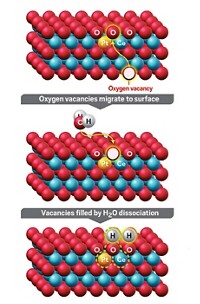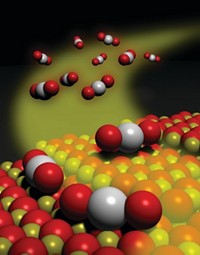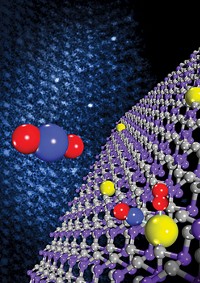Advertisement
Grab your lab coat. Let's get started
Welcome!
Welcome!
Create an account below to get 6 C&EN articles per month, receive newsletters and more - all free.
It seems this is your first time logging in online. Please enter the following information to continue.
As an ACS member you automatically get access to this site. All we need is few more details to create your reading experience.
Not you? Sign in with a different account.
Not you? Sign in with a different account.
ERROR 1
ERROR 1
ERROR 2
ERROR 2
ERROR 2
ERROR 2
ERROR 2
Password and Confirm password must match.
If you have an ACS member number, please enter it here so we can link this account to your membership. (optional)
ERROR 2
ACS values your privacy. By submitting your information, you are gaining access to C&EN and subscribing to our weekly newsletter. We use the information you provide to make your reading experience better, and we will never sell your data to third party members.
Energy
Improving Catalysts For Fuel Synthesis
Studies finger the causes of Fischer-Tropsch catalyst deactivation
by Mitch Jacoby
September 15, 2008
| A version of this story appeared in
Volume 86, Issue 37

WHOEVER SAID, "It's difficult to make predictions, especially about the future," probably wasn't referring to Fischer-Tropsch (FT) chemistry. But the adage is apt just the same.
The economics of commercializing FT synthesis—a catalytic carbon-carbon coupling process for making synthetic fuels and valuable chemicals—are driven in large part by the projected price of crude oil, "which is incredibly difficult to predict," Burtron H. Davis says. Davis, who is associate director of the Center for Applied Energy Research at the University of Kentucky, Lexington, says if the price of crude oil remains near today's record-high levels, then companies would have strong economic incentive to build new costly FT plants.
For now, however, only a small number of companies are investing in the new plants. One of them, Sasol, in a joint venture with Qatar Petroleum, is now completing the start-up phase of its recently constructed facility in the Persian Gulf state of Qatar. As plant operators ramp up production toward the facility's capacity of 34,000-barrels of synthetic fuels per day, Sasol researchers and their coworkers are collecting and analyzing data from pilot-scale demonstration units that operate under typical industrial conditions. Last month, several of those scientists presented results on catalyst performance at the American Chemical Society national meeting in Philadelphia at a symposium sponsored by the Division of Petroleum Chemistry.
In a brief overview of plant processes, Jan van de Loosdrecht, chief scientist at Sasol, explained that natural gas is treated with oxygen and steam to yield a mixture of CO and hydrogen known as synthesis gas or syngas, which in turn is polymerized in the presence of a cobalt-based FT catalyst. The process yields hydrocarbons, mainly paraffins, which are further treated to produce diesel and naphtha products. Overall, the fuel-producing technology is referred to as the gas-to-liquids (GTL) process.
Van de Loosdrecht pointed out that unlike diesel fuel produced via traditional petroleum refining, diesel made by way of the GTL process is inherently low in sulfur and nitrogen compounds, making the product a clean-burning, low-emissions transportation fuel. He added that in a well-publicized road test, a light truck fueled exclusively by GTL diesel was driven some 6,000 miles from South Africa to Qatar. Judging by the cleanliness of the engine oil and other parameters, the GTL-fueled vehicle outperformed the other vehicles in the expedition fleet, which ran on ordinary diesel.

IRON, COBALT, and other metals can be used to catalyze FT reactions. But cobalt is the "catalyst of choice," van de Loosdrecht says, because of the metal's high activity and its propensity for selectively producing linear paraffins and low levels of CO2. But cobalt is expensive, as are the precious metals that are sometimes included in small quantities in FT catalyst formulations to boost performance. For that reason, uncovering the fundamental processes that lead to catalyst deactivation and learning how to avoid or undo their effects is a top priority in FT chemistry.
At the ACS meeting, Sasol scientist Matthew J. Overett focused on the harmful effects of sintering, a process by which tiny catalyst particles agglomerate into larger ones, thereby causing catalyst surface area—and hence the number of accessible active sites—to shrink. By comparing unused catalysts to a series of samples that had been used in a pilot plant for a period of days to months, Overett observed that catalyst activity falls with continued use, dropping to 60% of the initial level by the end of two months. He also noted that catalyst particles sinter quickly when subjected to normal FT conditions.
On the basis of microscopy methods, magnetic measurements, and other types of analyses, Overett concluded that sintering occurs rapidly during the first few days of use and tapers off after 10–20 days. Overall, sintering appears to be responsible for roughly 25% of the long-term loss of catalyst activity, he said. But that process cannot be held accountable for deactivation that continues to weaken catalyst performance after a few weeks of use.
If sintering can't shoulder all the blame, what other processes conspire to diminish FT catalyst activity? In separate presentations, van de Loosdrecht and Hans J. W. Niemantsverdriet, a chemistry professor at Eindhoven University of Technology, in the Netherlands, addressed that question by presenting results from several recent studies that probed the roles played by oxidation, poisoning, and other deactivation mechanisms commonly discussed in catalysis literature.
Scratch oxidation from the list. According to Niemantsverdriet, synchrotron-based X-ray absorption measurements show that with continued use in an FT reactor, cobalt catalysts are increasingly reduced???not oxidized (Appl. Catal., A 2006, 312, 12; Catal. Today 2007, 123, 293).
CARBON DEPOSITION is a more likely culprit, Niemantsverdriet argued. By using a battery of analytical methods to study pilot-plant catalysts that had been used in a reactor for up to 180 days, he found a strong correlation between a gradual accumulation of a rather unreactive polymeric form of carbon (not graphite) and a loss of catalytic activity. In related theoretical work, Sasol and Eindhoven scientists determined that carbon deposition may lead to deactivation by triggering reconstruction of the catalyst crystal surface (Surf. Sci. 2008, 602, 17).
Sulfur and nitrogen compounds, if present, will also rob FT cobalt catalysts of their activity, van de Loosdrecht said. Scrubbing feedstocks of these contaminants is an obvious way to sidestep that problem, which in the case of sulfur poisoning is irreversible.
It turns out then that catalyst deactivation is a consequence of several mechanisms, including particle sintering, carbon buildup, and surface reconstruction. But don't cart away the catalyst for recycling just yet. According to van de Loosdrecht, a newly developed multistep procedure that includes oxidation and reduction steps can be used to restore catalyst activity. "We can regenerate our catalysts," he said, "and to a large extent, reverse most of the deactivation mechanisms."
Even with the latest advances in catalyst management, "it's still exceptionally hard to predict what the future will bring for FT chemistry," Davis remarked. "Industry's interest level has gone up and down over the years," he added. "Right now they seem very interested."





Join the conversation
Contact the reporter
Submit a Letter to the Editor for publication
Engage with us on Twitter